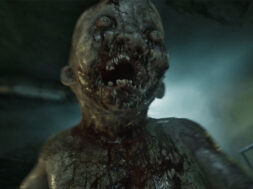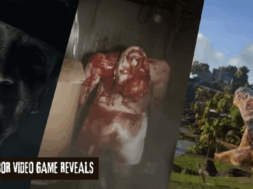In 2012, Scott Derrickson’s Sinister chilled audiences with gruesome 8mm snuff films of family annihilation. It’s a recent and excellent entry in the canon of “Cursed Tape” films, a subgenre of horror that was popularized by Hideo Nakata’s Ringu and Gore Verbinski’s 2002 American remake The Ring. While I’m nowhere near the first person to connect Sinister with The Ring, I suspect it’s not a connection many horror fans make. Despite the similar mechanisms, the films themselves have little in common. They do, however, fall into a narrow but impressive subgenre of “Found Footage” films that center around characters finding, or witnessing a piece of media that they shouldn’t.
Unlike the traditional Found Footage genre (e.g. The Blair Witch Project, REC, V/H/S, etc), these films, which I’ll call “Lost Footage,” center around a piece of media that has some sort of sinister history. Unlike found footage films, lost footage films focus on the characters who find these objects, and suffer the consequences. These aren’t always supernatural consequences, as we’ll see. Some of the most haunting entries here revolve around the existence of snuff films. While the threats that exist behind these tapes may not be as inherently terrifying as Sinister’s Bughuul or The Ring’s Sadako/Samara, they tend to elicit different, more visceral fears. Because the origins of snuff films are based in reality, viewers are reminded of just how deep humankind’s depravity can go.
While this may seem like a thin subgenre, it has some seriously impressive entries by a range of master filmmakers, plus some underseen gems. As a film fan, there’s something uniquely fascinating about these films. They tend to comment on the effect of film on its audience. Many question whether viewing violence makes us violent or desensitizes us to violence. Others question mankind’s fascination with horror films and the love of being scared. There’s also a significant amount of commentary on the craft itself, as well as the merits of amateurism, and its place among film.
It’s a particularly great time to spend some time catching up with these films. People are spending lots of time inside, binging copious amounts of video. Tiger King, Netflix’s hot new docuseries, is fascinating its audience with extreme amounts of voyeurism, and a subject who’s obsessed with the media spotlight. On top of that, Shudder has premiered its new series on “Cursed Films,” which covers the real films with disastrous productions. What better way to juxtapose those films than with a few of these….
Cigarette Burns (John Carpenter, USA/Canada, 2005)
John Carpenter’s Cigarette Burns is perhaps the purest example of a Lost Footage film. Released as part of Mick Garris’ Showtime series Masters of Horror, Cigarette Burns follows Kirby (Norman Reedus), a film dealer and an apparent “fixer” who’s trying to raise money to save a struggling movie theater. His prayers seem to be answered when he’s introduced to Bellinger (Udo Kier), a strange but wealthy film fanatic who offers him $100,000 to procure La Fin Absolue du Monde (The Absolute End of the World).
As is typical of the genre, Kirby learns that La Fin Absolue du Monde is apparently cursed, and all screenings have ended in murder and mayhem. Nonetheless, Kirby sets out to find the film. As he gets closer, the film becomes an obsession and rapidly consumes his sanity.
Released between Ghosts of Mars and The Ward, Cigarette Burns feels like a last hurrah at the end of Carpenter’s career. Not only is Cigarette Burns among the best entries in Masters of Horror, but it’s also easily in the upper tier of Carpenter films as well and would feel totally at home in his amazing run of films between 1980 and 1988 (The Fog through They Live, for the curious).
John Carpenter is not only a master director, but a master of selecting scripts, and both this and his other Masters of Horror entry, Pro-Life, are testaments to that. Pre-Walking Dead Norman Reedus is a joy to watch, as is the legendary Udo Kier, who’s at his best as a creepy benefactor. It’s delightfully reverent to film and horror-dom, with nods to Dario Argento, the Sitges Film Festival, Kenneth Anger, and many others. This is the perfect entry point into the genre for those who haven’t seen it and was an absolute joy to watch for the nth time.
Fury of the Demon (Fabien Delage, France/Croatia, 2016)
Lost Footage films come in a number of flavors. Cigarette Burns, mentioned above, is about the search for a lost film. The lore around that film is built as part of a character’s journey. Fury of the Demon eschews that journey and instead explores its central film, La rage du Démon (Fury of the Demon) in documentary format.
The film tracks the history of La rage du Démon, a 1897 silent film that has screened only three times, with each screening ending in death and mayhem. We learn from film critics, filmmakers, and film historians that La rage du Démon was likely made by Georges Méliès (A Trip to the Moon) early in his career. They explore Méliès’s influences and the motivations in filmmaking.
These analyses are supplemented by interviews with Pauline Méliès, Georges Méliès great-great-granddaughter.
Fury of the Demon is a fantastic entry in the Lost Footage canon in part because of its commitment to deception. The film provides excellent commentary on Méliès’s filmography and his lasting contributions to film. In particular, the film celebrates the man as a master of early special effects, and a pioneer of genre films, particularly fantasy and horror. Including his actual descendant grants the film credibility, as does its inclusion of real filmmakers such as Alexandre Aja (High Tension, Crawl)
While faux-docs can tread a fine line between homage and irreverence, Fury of the Demon falls squarely into the former category. It’s a posthumous celebration of a prolific filmmaker who didn’t receive the praise he deserved in his life. It’s a great nucleation point to dive into Méliès’ history and filmography, and another fantastic exploration of Lost Footage.
Antrum: The Deadliest Film Ever Made (David Amito and Michael Laicini, Canada, 2018)
Antrum begins with documentary-style content on Antrum, a 1979 film about a brother and sister who attempt to dig a hole to hell in order to save the soul of their recently euthanized dog. During a 1988 screening of the film in Budapest, Hungary, the theater erupted in flames, killing everyone in the audience. The film was later submitted anonymously to 7 film festivals, and while it wasn’t accepted into any, many of the judges and programmers who viewed the film died mysteriously. A later screening in San Francisco in 1993 caused an audience to break out in violence and hallucinations, which was later attributed to popcorn spiked with LSD.
A quick digression: I had a chance to see Antrum in San Francisco during its festival tour in early 2019. While the film is great on VOD, the roadshow apparently included a certain degree of theatrics that I’m sad to have missed. At this San Francisco screening, for example, the filmmakers handed out free popcorn to the unknowing crowd, setting the above up as a sadistic punchline.
The documentary portion only lasts about 8 minutes. Then, Antrum does something that no other film on this list does: It shows the entire cursed film. We subsequently follow a brother and sister as they travel with shovels to “The Antrum,” which is explained as being a threshold between earth and hell, where Satan landed when he was cast from heaven. As the plot unfolds, symbols and subliminal messages flash on screen, frames stutter, and at times sound plays in reverse, lending a constant sense of haunting to the film.
The plot of the cursed film is threadbare, but the imagery serves its purpose. Ashen demons linger in the woods, a giant metal Baphomet sits at the center of a hellish junkyard, and two children whisper prayers in a red tent in the middle of nowhere. As a “children in peril” film, it also manages to be surprisingly tense, as the protagonists experience the perils of hell.
S&Man (J.T. Petty, USA, 2006/2010)
Let’s take a break from cursed films for a minute to talk about snuff. While cursed films take up a major chunk of the Lost Footage subgenre, snuff films take up the other portion. For decades, at the fringes of horror, extreme films have been designed to emulate snuff films. Faces of Death, Mondo Cane, Guinea Pig, August Underground, and others have all sought to eschew narratives in favor of realistic death and violence.
S&Man explores these avenues of extreme horror by interviewing extreme horror filmmakers Fred Vogel (August Underground) and Bill Zebub (The Crucifier), as well as actors, fans, and filmmakers. These are juxtaposed with interviews with Carol Clover, acclaimed film academic and author of the 1992 book “Men, Women, and Chainsaws: Gender in the Modern Horror Film.” These interviews are contrasted further with a study of filmmaker Eric Rost (Erik Marcisak), who makes a series of extreme horror films called S&Man. As director J.T. Petty (The Burrowers, Soft for Digging) follows Rost deeper into the annals of his filmmaking process, it becomes less and less clear whether or not the films Rost makes are truly fiction.
Part of the fun of S&Man is that it intertwines genuinely fascinating documentary content with a taut narrative thriller. Petty’s own backstory and interest in voyeurism lead down fascinating paths. Vogel, Zebub, and actress Debbie D. are all highly amusing characters, and it’s a blast to experience their perspectives and filmmaking approaches. Even if you’re not a fan of extreme horror, S&Man is well worth a watch.
The tragedy of S&Man is that it was released without a place to live. Despite being well-received in its 2006 festival run, it wasn’t able to find distribution until 2010. When it finally did get released on DVD it came with a cadre of bonus features, but they weren’t enough to give S&Man the spotlight it deserved.
Berberian Sound Studio (Peter Strickland, UK, 2012)
With the recent wide-release of Peter Strickland’s newest film, In Fabric, now’s a great time to revisit his sophomore feature. Berberian Sound Studio moves to yet another facet of the genre. Rather than revolving around the hunt for a malicious film after it’s creation, Berberian Sound Studio takes place during the making of a film, The Equestrian Vortex. We follow Gilderoy (Toby Jones), an English sound engineer who’s been brought in to do foley, voiceovers, and sound mixing for an exceptionally gory Giallo film. As Gilderoy works on increasingly depraved effects for the film, his grip on reality slips, and he loses the ability to distinguish The Equestrian Vortex from reality.
Although not explicitly haunted, The Equestrian Vortex exudes the same mystique as other lost films mentioned. Stickland teases us with the title sequence and occasional clip, but rarely enough to parse a meaningful plot. It’s contrasted with Gilderoy’s own films, which are exceedingly droll compared to the sordid horrors of The Equestrian Vortex.
In many ways, Berberian Sound Studio is a confusing film. The plot is little more than an exploration of a premise. It meanders. It jumps around. The audience experiences Gilderoy’s descent into madness firsthand. We’re overwhelmed by jarring transitions, increasingly overwhelming sound, and unsubtitled Italian that leaves us struggling to keep up. It’s a bold film, but the choices work masterfully, and it becomes a complete cinematic experience.
Lovers of Giallo will be thrilled by the presentation. Strickland evokes Bava and Argento while creating a style that feels uniquely his own. It’s especially interesting to revisit the film after seeing In Fabric, as he’s really evolved the style in his most recent film into something new, beautiful, utterly bizarre, but not entirely unfamiliar. Strickland is easily one of the most interesting horror directors working today, and I’m excited to see what he makes next.
Videodrome (David Cronenberg, Canada, 1983)
I almost left Videodrome off of this list, not because it doesn’t deserve a spot, but because I almost feel it overshadows the rest of the list. I can hardly express how much I love this film, which tracks the descent of James Woods as Max Renn, a UHF (Ultra High Frequency) television producer as he searches for more and more extreme content. He finds this in the form of Videodrome, a pirate station that broadcasts footage of fetishistic torture and murder to the unknowing masses. In his quest to understand the truth behind Videodrome, Max becomes party to a massive conspiracy against all mankind. As he nears the truth, Max undergoes physical changes, and as his dreaming and waking life becomes inseparable from the violence of Videodrome, his body becomes a conduit for the ingestion of media.
Hopefully, those reading this are already familiar with Cronenberg, but for those who aren’t, he’s a master of “venereal horror.” The majority of his films, including The Fly (1988,) Dead Ringers, and Naked Lunch have heavy elements of body horror and physical transformation. The loss of the self is a common theme in many of his films, and it’s absolutely present in Videodrome. In this film, the self is consumed by television and leads to brainwashing, physical deformity, and eventual death.
In modern times, Videodrome feels oddly prescient. Dating back to the very birth of the 24-hour news cycle, Videodrome predicted a world where humanity is unknowingly enslaved by all-controlling media. Corporate entities conduct shadow wars through shell companies to control their viewers. And, of course, intrepid viewers like Max Renn voraciously seek out all that is cutting edge. (As an aside, I hope you’re enjoying this article. You should definitely keep reading and watch all these movies.)
Tesis (aka Thesis, Alejandro Amenábar, Spain, 1996)
Tesis comes from Alejandro Amenábar, who’s probably best known for his 1997 film Abre Los Ojos, which was remade in 2001 as Vanilla Sky. Tesis follows university student Angela, who’s just begun work on her thesis project on audiovisual violence. She begins her research with two routes of investigation. She asks her professor, Figueroa, if he can dig through the university’s archives for any films that are considered to be too gory or violent for general consumption. She then reaches out to the school’s resident horror-fan Chema to see if he can show her anything particularly perverse.
As Angela and Chema watch a supercut of real-life death, mayhem, and violence, Figueroa finds a hidden room in a dark corner of the archives loaded with unlabeled VHS tapes. He swipes one of the tapes and plays it in one of the school’s screening rooms. The next morning, Angela finds Figueroa dead. Rather than report the death, she steals the tape and ultimately watches it with Chema. They realize it’s a genuine snuff film, and set off on a hunt to find the sickos that made it. What ensues is a tense whodunnit with plenty of twists.
As the investigation ensues, the film takes breaks to remind the characters, and the audience, of Spain’s lack of a film industry. One of the university’s professors encourages students to “make what the people want.” Though Angela is outwardly disgusted by the violent images she’s exposed to, she’s consistently unable to look away. Though she calls Chema’s obsession with horror repugnant, she can’t avoid her fascination. Although it uses a hyperbolic metaphor, Tesis is an interesting look at mankind’s fascination with horror. Chema is a surprisingly good depiction of a horror fan, too. He immerses himself in film. His house is draped with posters, his shelves lined with tapes, and he wears nothing but horror t-shirts.
I have more than a few friends who he reminds me of.
8mm (Joel Schumacher, USA, 1999)
8mm feels like the perfect way to bring things full circle. While Cigarette Burns is about a man’s search for a cursed film, 8mm is about Nicolas Cage’s search for a snuff film. The setups are surprisingly similar: each man is hired by a wealthy benefactor. In the case of 8mm, however, Cage is hired to determine whether an alleged snuff film is real. To do so, he teams up with Joaquin Phoenix, who plays a plucky sex shop cashier with an incredible wardrobe and surprisingly in-depth knowledge of smut.
As you’ve probably guessed, that investigation leads the pair down darker and darker roads. They find a grotesque, porn-fueled underbelly of Hollywood that preys on up-and-coming stars to provide depraved content for those who can afford it. 8mm is a surprisingly nasty film. The snuff film at 8mm’s center is appropriately ugly, as is the film as a whole. Upon release, Roger Ebert surmised that it would have earned an NC-17 rating had it been released by an indie studio, and upon re-watch, that’s hard to argue with. I don’t typically think of Joel Schumacher as being a horror director, and while 8mm might be better classed as a thriller or a dark crime mystery, it’s certainly a horrific film. The script comes from Andrew Kevin Walker, the screenwriter behind Se7en, and the shared influence is apparent.
Nicolas Cage tends to be a divisive figure among horror fans (and film fans in general), but I personally love him as an actor. His recent surge in the horror world with Mom and Dad, Mandy, and Color Out of Space has been like a dream come true. While he draws critique for his over the top performances, I think the raw emotion he evokes works perfectly in horror. His reactions to terror may seem out of place among typical acting performances, but his sobbing-screaming-punching bouts of melodrama often seem appropriate for the incomprehensibly awful situations he finds himself in. His performance in 8mm is relatively tame compared to later films, but it also falls in the Cage-renaissance of the late 90s that spanned Leaving Las Vegas (1995) to Bringing out the Dead (1999).
The supporting cast is also phenomenal. Joaquin Phoenix plays Max California, who tutors Cage in the ways of sleaze. He spends a lot of time in leather pants and introduces himself to Cage by offering him a good deal on a battery-powered vagina. Other characters are equally colorful, including Peter Stormare as Dino Velvet, the sleaziest of fetish-porn producers. We also have James Gandolfini as a scummy talent scout, and even Norman Reedus in a minor role, again bringing us back to Cigarette Burns.

















